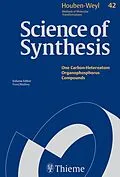Science of Synthesis provides a critical review of the synthetic methodology developed from the early 1800s to date for the entire field of organic and organometallic chemistry. As the only resource providing full-text descriptions of organic transformations and synthetic methods as well as experimental procedures, Science of Synthesis is therefore a unique chemical information tool. Over 1000 world-renowned experts have chosen the most important molecular transformations for a class of organic compounds and elaborated on their scope and limitations. The systematic, logical and consistent organization of the synthetic methods for each functional group enables users to quickly find out which methods are useful for a particular synthesis and which are not. Effective and practical experimental procedures can be implemented quickly and easily in the lab.// The content of this e-book was originally published in December 2008.
Zusammenfassung
Science of Synthesis: Houben-Weyl Methods of Molecular Transformations is the entirely new edition of the acclaimed reference series Houben-Weyl, the standard synthetic chemistry resource since 1909. This new edition is published in English and will comprise 48 volumes published between the years 2000 and 2008.
Science of Synthesis is a quality reference work developed by a highly esteemed editorial board to provide a comprehensive and critical selection of reliable organic and organometallic synthetic methods. This unique resource is designed to be the first point of reference when searching for a synthesis strategy.
- Contains the expertise of presently 400 leading chemists worldwide
- Critically evaluates the preparative applicability and significance of the synthetic methods
- Discusses relevant background information and provides detailed experimental procedures
For full information on the Science of Synthesis series, visit the Science of Synthesis Homepage
Inhalt
42.1 Product Class 1: Phosphinidenes and Terminal Phosphinidene Complexes
42.2 Product Class 2: Oxo-, Thioxo-, Selenoxo-, and Iminophosphines and Diphosphenes
42.3 Product Class 3: Phosphenium Salts
42.4 Product Class 4: Alkylphosphines
42.5 Product Class 5: Bis(alkylphosphino)- and Poly(alkylphosphino)alkanes, and Di- and Polyphosphines with a PâP Bond
42.6 Product Class 6: Cyclic Phosphines
42.7 Product Class 7: Dialkylphosphinous Acids and Derivatives
42.8 Product Class 8: Alkylphosphonous Acids and Derivatives
42.9 Product Class 9: Phosphorous Acid and Derivatives
42.10 Applications of Tricoordinated Phosphorus Compounds in Homogeneous Catalysis
42.10.1 General Catalytic Methods
42.10.2 Enantioselective Catalytic Methods
42.11 Applications of Tricoordinated Phosphorus Compounds in Organocatalysis
42.12 Product Class 12: Alkylphosphonium Salts
42.13 Product Class 13: Trialkylphosphine Oxides, Sulfides, Selenides, Tellurides, and Imides
42.14 Product Class 14: Dialkylphosphinic Acids and Derivatives
42.15 Product Class 15: Alkylphosphonic Acids and Derivatives
42.16 Product Class 16: Phosphoric Acid and Derivatives
42.17 Product Class 17: Phosphazenes
42.18 Product Class 18: Pentacoordinated Phosphoranes
42.19 Product Class 19: Hexacoordinated Phosphates
